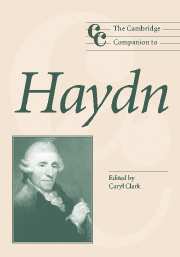Book contents
- Frontmatter
- Part I Haydn in context
- Part II Stylistic and interpretive contexts
- Part III Genres
- Part IV Performance and reception
- 14 A composer, his dedicatee, her instrument, and I: thoughts on performing Haydn's keyboard sonatas
- 15 Haydn and posterity: the long nineteenth century
- 16 The kitten and the tiger: Tovey's Haydn
- 17 Recorded performances: a symphonic study
- Notes
- Bibliography
- Index
15 - Haydn and posterity: the long nineteenth century
from Part IV - Performance and reception
Published online by Cambridge University Press: 28 September 2011
- Frontmatter
- Part I Haydn in context
- Part II Stylistic and interpretive contexts
- Part III Genres
- Part IV Performance and reception
- 14 A composer, his dedicatee, her instrument, and I: thoughts on performing Haydn's keyboard sonatas
- 15 Haydn and posterity: the long nineteenth century
- 16 The kitten and the tiger: Tovey's Haydn
- 17 Recorded performances: a symphonic study
- Notes
- Bibliography
- Index
Summary
Any study of Haydn's posthumous reputation must wrestle with several key problems. To start with, it may appear that Haydn's reception over the century following his death has little relevance to our engagement with the composer and his music: an essay on this topic might therefore seem to offer merely a stroll through the byways of nineteenth-century journalism and belles lettres, of marginal importance to our picture of Haydn. Yet many of the perspectives that emerged in the nineteenth century continue to shape popular perceptions of the composer. Indeed, Jens Peter Larsen has argued that it is an exaggeration to speak of a modern image of Haydn, as opposed to a diluted variant of earlier views. If Larsen is correct, it might seem that in exploring this topic, our task is to unmask the distortions that accrued over the course of the nineteenth century, to assert our own truths against earlier fallacies. Certainly, this impulse has motivated most studies of Haydn's reputation. For Leon Botstein, the “stubborn veneer of the nineteenth century” must be “dissolved and scraped away” if a new picture of Haydn is to emerge; similarly, in 1935 Adolf Sandberger claimed that “one of the most important artistic tasks of the present” was to discard earlier images of the composer in order to “re-establish the full truth.” But, as is evident from Sandberger's study, such attempts to assert the unadorned truth add their own layers of ideological veneer to the picture of Haydn.
- Type
- Chapter
- Information
- The Cambridge Companion to Haydn , pp. 226 - 238Publisher: Cambridge University PressPrint publication year: 2005
- 6
- Cited by



